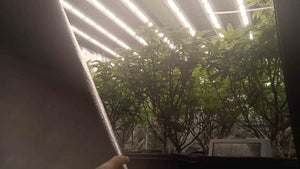How exciting would it be if any corner of your home could become a green plant paradise, where your plants continue to thrive even during South Africa's coldest winters or power outages!
While we cannot control weather and power supply, grow lights south africa are precisely the technological tools that make this dream a reality.
Although LED grow lights cannot directly "conjure up" sunlight, they can efficiently simulate the natural light spectrum, allowing you to grow your favorite plants anywhere indoors, whether succulents, herbs, or vegetables.
This article will provide a detailed analysis of how to choose the best LED grow lights in South Africa, introducing you to the characteristics of different types of lighting fixtures and offering professional advice on spectrum, power, and cost-effectiveness.

What are LED Grow Lights? Why are They So Important?
LED grow lights are artificial light sources specifically designed for indoor plants, capable of providing the specific spectrum needed for plant photosynthesis. Unlike traditional incandescent or fluorescent lights, led grow lights south africa use advanced light-emitting diode technology to precisely control light color and intensity.
Why Do Plants Need Specific Spectrums?
Here's some interesting science. Plants don't simply "see" light; they "absorb" light energy through chlorophyll and other pigment molecules. Different colored light wavelengths have dramatically different effects on plants:
- Blue Light (400-500nm): Promotes leaf growth and plant structural development
- Red Light (600-700nm): Stimulates flowering and fruiting
- Green Light (500-600nm): Helps light penetrate deep into leaves
- Far-Red Light (700-800nm): Affects plant morphology and flowering behavior
It's precisely because of plants' different spectrum requirements that full spectrum led grow lights south africa have become the best choice for indoor growing.
Why Choose LED Over Other Types of Grow Lights?
In the South African market, you'll find various types of grow lights, but LED grow lights stand out with their unique advantages:
Energy Efficiency: Smart Choice for Rising South African Electricity Prices
Based on actual experience from South African growers, LED grow lights are more energy-efficient compared to HPS or CFL fixtures, which is especially important given South Africa's continuously rising electricity prices. A 320-watt LED grow light can provide the same lighting effect as a 600-watt HPS light, saving nearly 50% on electricity bills.
Heat Management: Simplified Temperature Control Systems
Traditional high-pressure sodium (HPS) lights typically operate at 70-80°C, while quality LED grow lights operate at only 55-65°C. This means you don't need complex ventilation and cooling systems, particularly suitable for South Africa's high summer temperatures.
Lifespan: Long-term Investment Returns
High-quality full spectrum LED grow lights can operate for up to 50,000 hours—equivalent to over 5 years of continuous operation. In comparison, fluorescent lights have a lifespan of about 2 years, and HPS lights last 1-3 years.
How to Choose the Right LED Grow Light for You?
Choosing the best led grow lights isn't simple, but if you master the following key factors, you can make an informed decision:
1. Power and Coverage Area
This is the most easily misunderstood parameter. Many people think higher power is better, but what you actually need to consider is Photosynthetic Photon Flux Density (PPFD) rather than simple wattage.
Practical Recommendations:
- Small growing area (60cm x 60cm grow tent): Choose 100-150 watt LED lights
- Medium growing area (90cm x 90cm grow tent): Choose 200-300 watt LED lights
- Large growing area (120cm x 120cm grow tent): Choose 400-600 watt LED lights
- Large growing area (150cm x 150cm grow tent): Choose 600-800 watt LED lights
2. Spectrum Type: Full Spectrum vs. Custom Spectrum
Full spectrum LED grow lights simulate natural sunlight, containing all wavelengths needed by plants. This type of fixture is suitable for:
- Novice growers
- Mixed cultivation of different plant types
- Situations requiring observation of plants' natural colors
Custom spectrum LED grow lights allow you to adjust the proportions of different colors, suitable for:
- Experienced growers
- Professional cultivation of specific plant varieties
- Situations requiring precise control of plant growth stages
3. Brand and Quality Certification
In the South African market, choosing brands with local after-sales service support is crucial. South African growers particularly value quality customer service, and choosing brands with local support can avoid maintenance and replacement hassles.
Companies like TheOneGrow have local branches and warehouses exceeding 500 square meters in South Africa, ensuring fast and convenient product supply with shortened delivery times.
They also provide strong after-sales support, with a 7*24-hour professional service team ready to provide technical support and problem resolution for customers at any time.
Characteristics of Different Types of LED Grow Lights
Led Panel Light

Quantum boards are currently the most popular type of LED grow lights, arranging multiple high-quality LED chips on a heat sink board.
Advantages:
- Even light distribution
- Good heat dissipation
- High energy efficiency ratio
- Easy installation
Suitable Scenarios:
- Small to medium grow tents
- Home indoor growing
- Supplemental lighting for commercial growing
Recommendation: 200W led panel light
The 200W led panel light features matrix LED layout with even light distribution and high efficiency of 2.9 µmol/J, PPF output of 580 µmol/s. Equipped with full spectrum design and 660nm red light, simulating natural sunlight, suitable for 90×90cm grow tents, with free delivery in South Africa.
COB LED Grow Lights
COB (Chip-on-Board) technology integrates multiple LED chips in one package, providing high-intensity concentrated light sources.
Advantages:
- Strong light penetration
- Suitable for tall plants
- Concentrated light efficiency
Suitable Scenarios:
- Large growing spaces
- Plants requiring deep light penetration
- Commercial growing facilities
LED Light Strip Grow Lights

This design arranges LED chips on elongated light strips that can be flexibly combined. Like TheOneGrow's 800W led grow lights, featuring foldable design for convenient transportation, equipped with Samsung LED chips, high efficiency of 2.6 µmol/J, PPF reaching 2080 µmol/s.
Equipped with 8 LED light bars and 120° beam angle, providing wide coverage and even light distribution. Suitable for 150x150x200cm grow tents or commercial growing.
Advantages:
- Flexible installation
- Free combination possible
- Suitable for irregular growing areas
Suitable Scenarios:
- Multi-tier growing racks
- Irregular growing spaces
- Situations requiring precise lighting control
Installation and Usage Tips
Importance of Hanging Height
The hanging height of LED grow lights directly affects lighting effectiveness and plant health:
Recommended Distances:
- Seedling stage: 30-45cm
- Growth stage: 20-30cm
- Flowering stage: 15-25cm
Light Duration Settings
Different plants have different light duration requirements:
Vegetable Plants:
- Growth stage: 16-18 hours/day
- Flowering stage: 12-14 hours/day
Herb Plants:
- Throughout growth: 14-16 hours/day
Succulent Plants:
- Daily maintenance: 8-12 hours/day
Temperature and Humidity Control
Even though LED grow lights generate less heat, you still need to monitor the growing environment. It's best to purchase a temperature-humidity meter to monitor conditions:
Ideal Conditions:
- Temperature: 18-25°C
- Humidity: 50-70%
- Air circulation: Good
Energy Efficiency and Environmental Considerations
Electricity Cost Calculation
In South Africa, electricity prices are an important consideration when choosing grow lights. Here's a simple electricity cost calculation method:
Monthly electricity cost = Light power (kW) × Daily usage hours × 30 days × Electricity rate (Rand/kWh)
Example: 300-watt LED light, used 16 hours daily Monthly electricity cost = 0.3 × 16 × 30 × 2.5 = 360 Rand
Purchase Recommendations and Budget Planning
Entry-Level Choice (1000-3000 Rand)
Suitable for beginners or small-scale growing, basic LED grow lights typically 100-200 watts, covering approximately 0.5-1 square meter.
Intermediate Choice (3000-8000 Rand)
Suitable for experienced growers, 200-400 watts with dimming functions and better spectrum control.
Advanced Choice (8000+ Rand)
Suitable for professional growers or commercial use, 400+ watts with intelligent control systems and precise spectrum adjustment functions.
Common Problems and Solutions
Yellow Plant Leaves:
- Possible cause: Light too strong or too weak
- Solution: Adjust light height or reduce lighting time
Plant Stretching:
- Possible cause: Red light ratio too high
- Solution: Increase blue light ratio or shorten lighting time
Plants Not Flowering:
- Possible cause: Lighting time too long
- Solution: Adjust to 12 hours light/12 hours dark cycle
Conclusion
Through this guide, we believe you now have a comprehensive understanding of grow lights south africa.
Modern LED grow lights, with their excellent energy efficiency ratios, precise spectrum control, and long lifespan, have become the ideal choice for indoor growing in South Africa. Whether you want to grow herbs in winter or maintain plant health during power outages, the best led grow lights can provide you with perfect solutions.
If you're looking for reliable LED grow light suppliers, TheOneGrow as South Africa's leading plant growing equipment manufacturer, offers a complete range of products from entry-level to professional grade, along with comprehensive after-sales service support. Their products cover various power and spectrum configurations to meet different growing needs.
Start your indoor growing journey now, choose the LED grow light products that suit your needs, and make this challenging era more green and vibrant!
FAQs
Can LED Grow Lights Replace Sunlight?
Yes, full spectrum led grow lights south africa can provide the complete spectrum plants need, completely replacing natural sunlight. Many indoor growers have proven that plants grown under LED lights perform even better than those under natural lighting.
How Much LED Power Do I Need?
According to experienced grower recommendations, an average of 200-400 watts of LED power per square meter is needed, depending on plant type and growth stage.
Do LED Grow Lights Produce UV Radiation?
Most LED grow lights produce very little UV radiation and are relatively safe for humans. However, looking directly at LED lights for extended periods may still harm eyes; wearing protective eyewear during use is recommended.
How to Judge LED Grow Light Quality?
Key Indicators:
- Photosynthetic Photon Flux Density (PPFD) values
- Spectrum distribution charts
- Lifespan guarantees
- Brand reputation and after-sales service
- Third-party test reports

